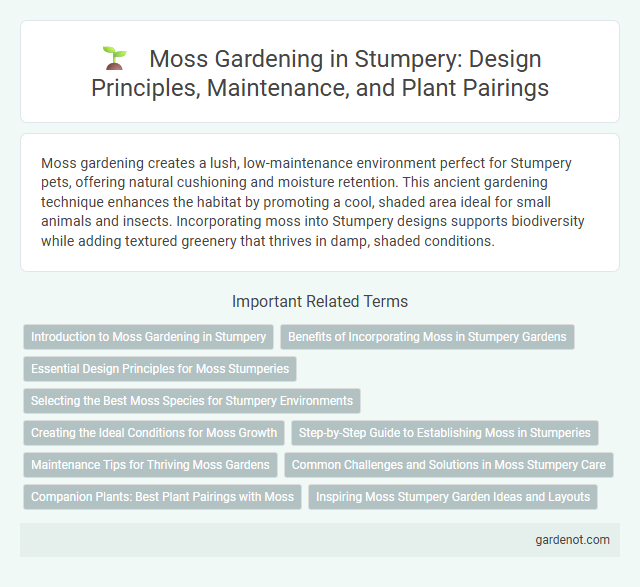Moss gardening creates a lush, low-maintenance environment perfect for Stumpery pets, offering natural cushioning and moisture retention. This ancient gardening technique enhances the habitat by promoting a cool, shaded area ideal for small animals and insects. Incorporating moss into Stumpery designs supports biodiversity while adding textured greenery that thrives in damp, shaded conditions.
Introduction to Moss Gardening in Stumpery
Moss gardening in stumpery integrates diverse moss species to create lush, textured landscapes that thrive in shaded, moist environments. Stumperies utilize decayed wood and natural stone arrangements to provide ideal microhabitats, promoting moss propagation and biodiversity. Moss's low-maintenance, moisture-retentive properties enhance the ecological value and aesthetic appeal of stumpery designs.
Benefits of Incorporating Moss in Stumpery Gardens
Incorporating moss in stumpery gardens enhances moisture retention and soil stability, creating a lush, green carpet that thrives in shaded, damp environments. Moss contributes to biodiversity by providing habitat for microfauna and improving air quality through its natural filtration properties. Its low maintenance requirements and ability to prevent erosion make moss an eco-friendly and sustainable choice for stumpery garden design.
Essential Design Principles for Moss Stumperies
Moss stumperies thrive by integrating natural tree stumps as structural elements, promoting moisture retention and providing varied textures that enhance moss growth. Essential design principles include selecting shaded, humid environments to mimic moss's native habitat and arranging stumps at varying heights and angles to create microclimates conducive to different moss species. Incorporating decayed wood and ensuring consistent soil acidity further optimize conditions for a lush, thriving moss stumpery.
Selecting the Best Moss Species for Stumpery Environments
Selecting the best moss species for stumpery environments involves choosing varieties that thrive in shaded, moist conditions with ample organic matter. Popular moss species such as Hypnum cupressiforme, Dicranum scoparium, and Bryum capillare are well-suited due to their adaptability and resilience on decaying wood and stone surfaces. Ensuring the mosses are native or well-adapted to the local climate enhances growth success and biodiversity within the stumpery garden.
Creating the Ideal Conditions for Moss Growth
Creating the ideal conditions for moss growth involves maintaining consistently moist, shaded environments with acidic, well-drained soil rich in organic matter. Moss thrives in areas with low light and high humidity, making it essential to reduce direct sunlight exposure and provide adequate moisture through regular watering or misting. Avoiding soil disturbance and minimizing competition from other plants supports healthy moss colonization and expansion.
Step-by-Step Guide to Establishing Moss in Stumperies
Establishing moss in stumperies begins with selecting a shaded, moist area and preparing the wood stumps by cleaning off loose bark and debris to create a suitable surface for moss attachment. Next, collect moss fragments or spores from nearby environments, mixing them with buttermilk or yogurt to create a nutrient-rich slurry that can be spread over the stumps to encourage colonization. Maintain consistent moisture through regular misting and avoid direct sunlight to promote healthy moss growth, ensuring the stumpery develops a lush, green carpet over time.
Maintenance Tips for Thriving Moss Gardens
Maintaining a thriving moss garden requires consistent moisture, minimal direct sunlight, and regular removal of debris to prevent mold and rot. Ensuring the soil pH stays between 5.0 and 6.0 promotes optimal moss growth, while occasional misting during dry periods supports hydration. Avoiding foot traffic and compacting the moss bed preserves its delicate structure and encourages lush, healthy development.
Common Challenges and Solutions in Moss Stumpery Care
Maintaining a moss stumpery requires addressing common challenges such as excess moisture, improper shading, and competition from weeds. Ensuring consistent damp conditions with well-drained soil and providing partial to full shade promotes healthy moss growth. Regularly removing invasive plants and avoiding heavy foot traffic mitigates disturbance, fostering a thriving moss garden.
Companion Plants: Best Plant Pairings with Moss
Ideal companion plants for moss gardening include ferns, hostas, and shade-loving groundcovers like wild ginger, all of which thrive in similar moist, shady environments. These plants enhance the aesthetic appeal by providing contrasting textures and heights, while maintaining the humidity and soil conditions that moss requires for optimal growth. Incorporating companion plants such as hellebores and astilbes also supports biodiversity and helps create a balanced, resilient moss garden ecosystem.
Inspiring Moss Stumpery Garden Ideas and Layouts
Moss stumpery gardens create enchanting natural sculptures by artfully arranging moss-covered tree stumps and logs in shaded, moist environments that promote lush growth. Incorporate diverse moss species like sheet moss, cushion moss, and haircap moss to achieve varying textures and vibrant green hues, while pairing them with ferns and woodland flowers for added visual interest. Design layouts using winding paths and layered stump heights to mimic natural woodland settings, enhancing both depth and tranquility in your garden space.
Moss gardening Infographic

 gardenot.com
gardenot.com